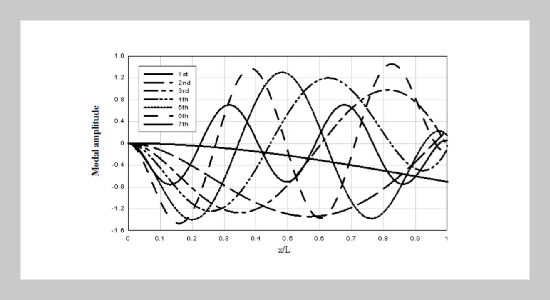REFERENCES
- [1] Pan, Y., Agrawal, A. K. and Ghosn, M., “Seismic Fragility of Continuous Steel Highway Bridges in New York State,” Journal of Bridge Engineering, Vol. 12, No. 6, pp. 689�699 (2007). doi: 10.1061/(ASCE) 1084-0702(2007)12:6(689)
- [2] Zhong, J. S., Gardoni, P., Rosowsky, D. and Haukaas, T., “Probabilistic Seismic Demand Models and Fragility Estimates for Reinforced Concrete Bridges with Two-Column Bents,” Journal of Engineering Mechanics, Vol. 134, No. 6, pp. 495�504 (2008). doi: 10.1061/(ASCE)0733-9399(2008)134:6(495)
- [3] Liang, C.-C., Yang, M.-F. and Tai, Y.-S., “Prediction of Shock Response for a Quadrupod-Mast Using Response Spectrum Analysis Method,” Ocean Engineering, Vol. 29, No. 8, pp. 887�914 (2002).
- [4] Shattarat, N. K., Symans, M. D., McLean, D. I. and Cofer, W. F., “Evaluation of Nonlinear Static Analysis Methods and Software Tools for Seismic Analysis of Highway Bridges,” Engineering Structures, Vol. 30, No. 5, pp. 1335�1345 (2008). doi: 10.1016/j.engstruct.2007.07.021
- [5] Nielson, B. G. and DesRoches, R., “Seismic Fragility Methodology for Highway Bridges,” Structural Engineering and Public Safety, Proceedings of the 2006 Structures Congress, May 18-21, St Louis, Missouri, pp. 1�9 (2006). doi: 10.1061/40889(201)174
- [6] Yang, C. S., DesRoches, R. and Padgett, J. E., “Analytical Fragility Models for Box Girder Bridges with and without Protective Systems,” Proceedings of the 2009 Structures Congress, Austin, Texas (2009). doi: 10.1061/41031(341)151
- [7] Kim, S. H. and Shinozuka, M., “Fragility Curves for Concrete Bridges Retrofitted by Column Jacketing and Restrainers,” Proceedings of 6th U.S. Conference and Workshop on Lifeline Earthquake Engineering, Long Beach, California (2003). doi: 10.1061/40687 (2003)92
- [8] Porter, K., Hamburger, R. and Kennedy, R., “Practical Development and Application of Fragility Functions,” Proceedings of the 2007 Structures Congress, Long Beach, California (2007). doi: 10.1061/40944(249)23
- [9] Zhang, J. and Huo, Y., “Fragility Function of Base Isolated Highway Bridges,” Proceedings of 18th Analysis and Computation Specialty Conference, Vancouver, BC, Canada, pp. 1�17 (2008). doi: 10.1061/40944 (249)23
- [10] Chaudhuri, S. R. and Hutchinson, T. C., “Fragility of Bench-Mounted Equipment Considering Uncertain Parameters,” Journal of Structural Engineering, Vol. 132, No. 6, pp. 884�898 (2006). doi: 10.1061/(ASCE) 0733-9445(2006)132:6(884)
- [11] Wilcoski, J., Gambill, J. B. and Smith, S. J., The CERL Equipment Fragility and Protection Procedure (CEFAPP), Experimental Definition of Equipment Vulnerability to Transient Support Motions, US Army Corps of Engineers Construction Engineering Research Laboratories, USACERL Technical Report 97/58, March, p. 140 (1997).
- [12] Dastous, J. B. and Filiatrault, A., “Seismic Displacement at Interconnection Points of Substation Equipment,” Proceedings of 6th U.S. Conference and Workshop on Lifeline Earthquake Engineering, Long Beach, California (2003). doi: 10.1061/40687(2003)61
- [13] Straub, D. and Der Kiureghian, A., “Improved Seismic Fragility Modeling from Empirical Data,” Structural Safety, Vol. 30, No. 4, pp. 320�336 (2008). doi: 10.1016/j.strusafe.2007.05.004
- [14] Zhu, Z. Y. and Soong, T. T., “Toppling Fragility of Unrestrained Equipment,” Earthquake Spectra, Vol. 14, No. 4, pp. 695�712. doi: 10.1193/1.1586023
- [15] Safford, F. B. and Tuttle, R. J., “Transient Shock Fragility and Hardness Assessment of Commercial Communications Equipment,” SAE International, Document No.740801, February (1974). doi: 10.1016/ 0022-460X(89)90742-6
- [16] Cunniff, P. F. and O'Hara, G. J., “A Procedure for Generating Shock Design Values,” Journal of Sound and Vibration, October, Vol. 134, No. 1, pp. 155�164 (1989). doi: 10.1016/0022-460X(89)90742-6
- [17] Salmonte, A. J., “Evaluation of Secondary and Higher Order Response Facets in Response Spectrum Analysis,” Nuclear Engineering and Design, November, Vol. 109, No. 3, pp. 433�454 (1988). doi: 10.1016/ 0029-5493(88)90288-9
- [18] Merkle, D. H, Rochefort, M. A. and Tuan, C. Y., “Equipment Shock Tolerance,” Final Report, ESLTR-92-65, U.S. Air Force Civil Engineering Support Agency, Tyndall Air Force Base, FL, April, p. 63 (1993).
- [19] Coomes, J. R. and Roberts, W. B., “Report of Test on BUZZER, TYPE A-3 Submitted by Navy Yard, Portsmouth, N. H.,” Naval Research Laboratory, Washington, DC, NRL-1396, p. 10 (1937).
- [20] Kiger, S. A., Balsara, J. P. and Baylot, J. T., “A Computational Procedure for Peak In-structure Motions and Shock Spectra for Conventional Weapons,” The Shock and Vibration Bulletin No. 54, Part 2, June, pp. 223� 226 (1984).
















